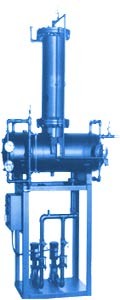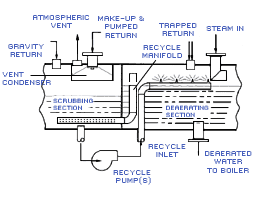
Deaerators are used to remove oxygen from boiler feedwater.
Industrial Steam designs and manufacturers a complete line of Boiler pre-treatment equipment including:
- Deaeration Systems
- Boiler Feedwater Systems
- Blowdown Systems (Intermittent and Continuous)
- Heat Recovery Systems
Atmospheric Deaerators
The Spray Flow II (SP5II) Atmospheric Deaerators offers a Guaranteed performance of .005 cc/1 from 0-100% load.
- Split-section receiver with integral recycle pump
- Unique design eliminates the threat air re-entry
- Eliminates high vent losses common to other atmospheric designs
How it works:
Modulated make-up water is sprayed through a stainless steel spring-loaded nozzle into a stainless steel internal vent condenser located in the scrubbing section. The nozzle produces a thin conical sheet of water, which condenses the vapors while permitting oxygen to exit through the unrestricted atmospheric vent. Pumped low temperature returns are also sprayed through the nozzle. Gravity returns flow unrestricted to the scrubbing section.
The combined make-up and returns in the scrubbing section is heated with steam and recycled deaerated water from the deaerating section. Both the steam and the deaerated water enter the scrubbing section through separate stainless steel manifolds. The perforated steam manifold provides jets of steam to vigorously scrub the major portion of the dissolved oxygen from the make-up, pumped returns, and gravity returns. The temperature in the scrubbing section is controlled at 208oF at sea level, which assures the release of the majority of the dissolved oxygen without flash loss.

The scrubbing section water, which is nearly fully deaerated, is continuously recycled to the deaerating section where it is sprayed through stainless steel, wide angle, full cone nozzles. Steam enters the deaerating section in response to the temperature in the scrubbing section. Since the cycle is continuous, pure steam is always available for final deaeration. The last traces of oxygen are removed at the point of contact with the purest steam. Excess, fully deaerated water flows continuously from the deaerating section to the scrubbing section through the stainless steel recycle manifold. Trapped returns are piped to the deaerating section where flash steam is prefentially used for final deaeration.
Since the recycle pump capacity exceeds the deaerator capacity by at least 25%, the deaerator is able to meet 0.005 cc/l, from zero to 100% load. This same feature also enables the deaerator to supply fully deaerated water to the boiler on start-up. Rapid load changes and on-off boiler feedwater controls. which are very troublesome for other atmospheric Deaerators, will not affect the Spray Flow II’s performance or operation.
Pressurized Deaerators
How it works:
Water flow – Incoming undeaerated water and pumped returns enter the deaerator through a spring-loaded stainless steel nozzle, which directs the flow in conical sheets into the steam atmosphere of the direct contact vent condenser. At this point, the water temperature is raised to within a few degrees of steam temperature and most of the corrosive, non-condensable gases are removed. The water is directed by a stainless steel tray section into the Jet Spray atomizing valve. Here a high velocity of incoming pure steam literally atomizes the water into minute particles. This violet scrubbing action removes the last traces of dissolved gases. The hot, deaerated water then falls to the storage compartment for boiler use.

Steam Flow – Steam initially enters the deaerator through a special, stainless steel Jet Spray atomizing valve. This valve is designed to fully atomize and provide complete deaeration under all load conditions. This design insures that the purest steam comes in contact with the purest water. Once this high velocity steam mechanically shakes out the last traces of non-condensable gases from the water, it flows upward into the preheater area where it meets the incoming make-up water and pumped returns. This water continuously condenses the steam, which preheats and releases the non-condensable gases into the internal vent condenser where they are metered harmlessly to the atmosphere. This action causes more steam to be drawn into 6the system to complete the cycle.
Tray type Deaerators
Boiler feedwater enters the vertical deaeration section above the perforated trays and flows downward through the perforations. Low-pressure deaeration steam enters below the perforated trays and flows upward through the perforations. Some designs use various types of packed bed, rather than perforated trays, to provide good contact and mixing between the steam and the boiler feed water.
The steam strips the dissolved gas from the boiler feedwater and exits via the vent valve at the top of the domed section. Should this vent valve not be opened sufficiently the deaerator will not work properly, causing high oxygen content in the feed water going to the boilers. Should the boiler not have an oxygen content analyser a high level in the boiler chlorides may indicate the vent valve not being far enough open. Some designs may include a vent condenser to trap and recover any water entrained in the vented gas. The vent line usually includes a valve and just enough steam is allowed to escape with the vented gases to provide a small visible telltale plume of steam.
The deaerated water flows down into the horizontal storage vessel from where it is pumped to the steam generating boiler system. Low-pressure heating steam, which enters the horizontal vessel through a sparger pipe in the bottom of the vessel, is provided to keep the stored boiler feedwater warm. External insulation of the vessel is typically provided to minimize heat loss.
